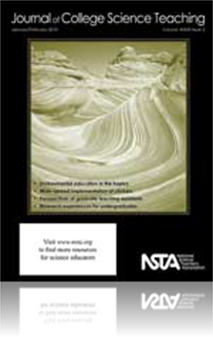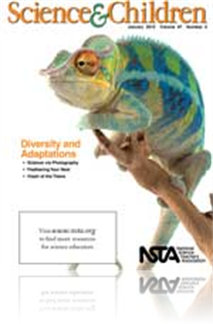All Resources
Journal Article
Point of View: How to Survive an Academic Job Interview
Career development is an important issue, and there are aspects of finding the right position that are particular to science faculty. Although this article does not follow the usual format and subject of submissions to our Point of View column, we ha...
Journal Article
WebQuests and the 5E learning cycle are titans of the science classroom. These popular inquiry-based strategies are most often used as separate entities, but the author has discovered that using a combined WebQuest and 5E learning cycle format taps i...
Journal Article
Environmental Education and Service Learning in the Tropics: Making Global Connections
Research has suggested that a service-learning component can add a powerful dimension to learning course content in a variety of science disciplines, in addition to assisting students in seeing connections between their studies and the world outside ...
Journal Article
As science teachers at a suburban California high school, the authors were concerned about the lab report conclusions written by their upper-level chemistry, biology, and ecology students—which were consistently of poor quality. Their work lacked i...
Journal Article
Science Sampler: SSSNOW Project—Helping make science cool for students
In the atmosphere or on the ground, snow provides students with unique opportunities to discover winter weather patterns. Traditionally, when students study weather, it is limited to the collection of data one would see on a weather report. However, ...
Journal Article
Case Study: The Chemistry of Curcumin, the Health Promoting Ingredient in Turmeric
Case studies pertaining to the health benefits of foods can be particularly effective in engaging students and in teaching core concepts in science (Heidemann and Urquart 2005). This case study focuses on the chemistry of curcumin, the health-promoti...
Journal Article
Tech Trek: Cell phones for science
Although in some schools cell phones have to be turned off or perhaps kept in lockers to avoid misuse, the authors hope to demonstrate in this article how they can be used under supervision to assist learning. This ubiquitous device can be a powerful...
Journal Article
Science Sampler: Is knowledge random? Introducing sampling and bias through outdoor inquiry
Sampling, very generally, is the process of learning about something by selecting and assessing representative parts of that population or object. In the inquiry activity described here, students learned about sampling techniques as they estimated th...
Journal Article
How Middle School Students Come Face to Face With Down Syndrome Research
This article discusses how real research on Down syndrome, being done in a lab at Indiana University-Purdue University Indianapolis (IUPUI), was incorporated into a laboratory activity for middle school students. The activity asked students to evalua...
Journal Article
To encourage students to seek research opportunities with campus faculty, one large university in the Southeast created a course entitled Science for All. A major goal of the course was to encourage students to work directly with faculty on research ...
Journal Article
Career of the Month: An Interview With Medical Diagnostics Scientist Bernhard Weigl
Medical diagnostics help us evaluate a range of disorders, such as cancer and infectious diseases. In the United States and other developed countries, doctors have access to advanced equipment and laboratories that provide reliable diagnoses. As a re...
Journal Article
Eight Earth science graduate teaching assistants (GTAs) participated in a semester-long seminar designed to facilitate change in their practice. The seminar used lesson-study methodology to facilitate discussion of GTAs’ beliefs about teaching whil...
Journal Article
As an amateur photographer and science teacher, the author shares how to use digital media to enhance the study of habitat and adaptation. The author also helps you to discover how to use the camera to boost science vocabulary, especially for English...
Journal Article
Scope on Safety: Common sense and chemicals
This month’s column features two true stories about the use of chemicals in the middle school science classroom. The lesson of these stories is simple. Certainly, it is prudent to have age-appropriate experiences in science, given the developmental...
Journal Article
Students love a mystery. So what do America’s most majestic bird, a bag of habitat clues, and a soft-shelled egg have in common? This easy-to-do inquiry activity engages students as they connect clues to problem-solve how the bald eagle reached the...
Journal Article
Every Day Science: January 2010
This monthly feature contains facts and challenges for the science explorer....
Journal Article
Safer Science: Lab Fire Extinguishers—Here Today, Gone Tomorrow?
When renovations or new construction occur, fire extinguishers sometimes get lost in the mix. Unfortunately, whether to save money or because the fire code is misinterpreted, some schools do not install fire extinguishers in laboratories and other ar...
Journal Article
The Prepared Practitioner: Literature Circles
Using literature to help students better understand the nature of science often involves some combination of historical vignettes, case studies, or readers’ theater. Straits (2007) discusses a different approach for using historical nonfiction in t...
Journal Article
Predicting The Timing And Location of the Next Hawaiian Volcano
The wealth of geologic data on Hawaiian volcanoes makes them ideal for study by middle school students. In this paper the authors use existing data on the age and location of Hawaiian volcanoes to predict the location of the next Hawaiian volcano and...
Journal Article
Natural Resources: Close to Home
Learning about endangered or threatened species can be an extension of an adaptation or biodiversity lesson. It can also be tied into conversation and what students (and the rest of us) can do to help species in need. Before your students head outdoo...
Journal Article
Too often, students enter our classrooms with insufficient knowledge of physical science. As a result, they have a difficult time understanding content in texts, lectures, and laboratory activities. This lack of background knowledge can have an impac...
Journal Article
Science Shorts: How Symbiosis Creates Diversity
Diversity in habitats on Earth is astounding—whether on land or in the sea—and this is in part due to symbiosis. The lesson described in this article helps students understand how symbiosis affects different organisms through a fun and engaging g...






